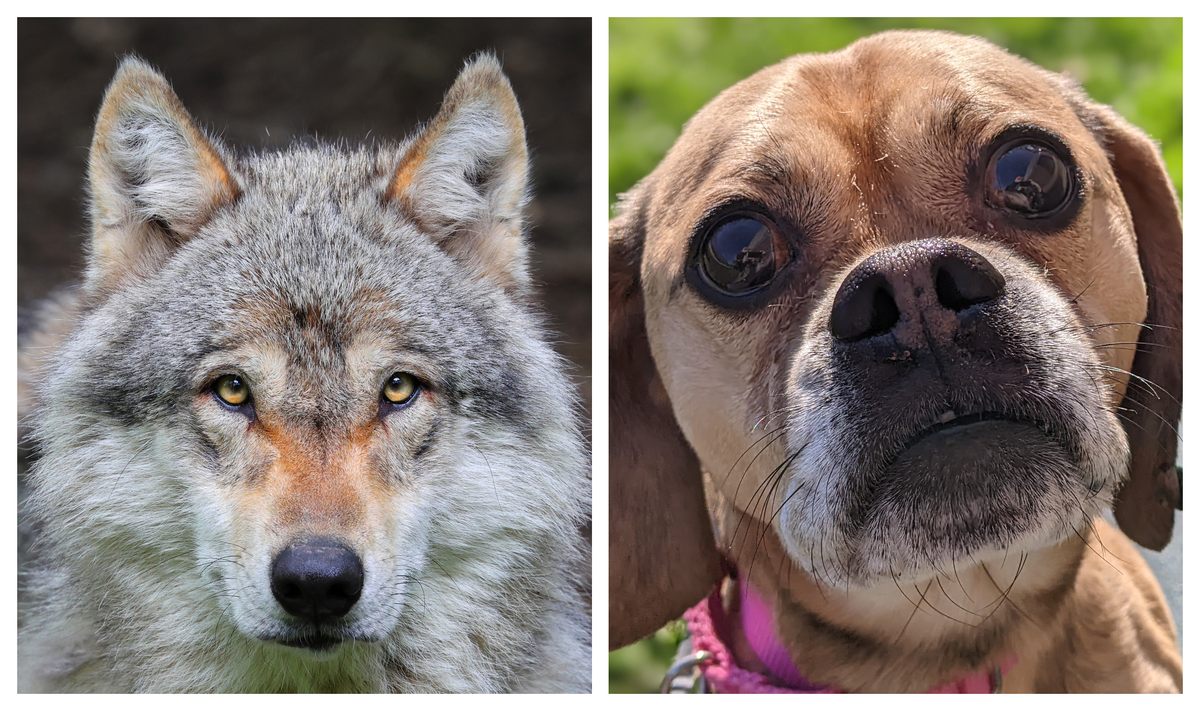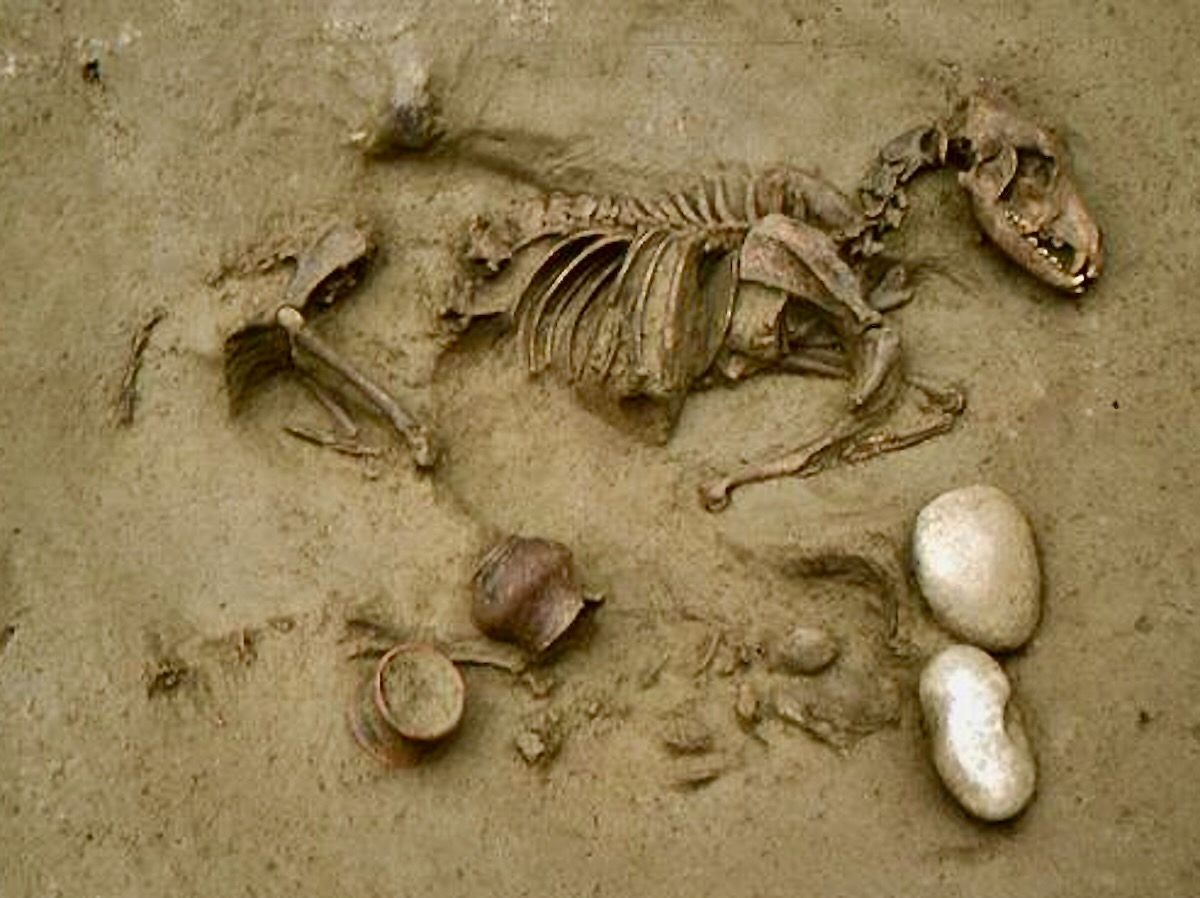When Did Dogs Become Our Best Friends?
A poignant, 2,000-year-old burial in northern Italy could be the latest evidence of an ancient friendship.

The river known today as the Adige, the second-longest in Italy, flows south and then east from the Alps to the Adriatic. As it travels around hills and through flatlands, the river meanders widely, sometimes nearly looping back on itself. The city of Verona took root and grew around one of these meanders more than 2,000 years ago and, around that time, not far from the banks, an infant was laid to rest in a humble grave. She did not go into the afterlife completely alone, however. Alongside her fragile little bones, its paws tucked as if napping, is the complete skeleton of a dog.
Archaeologists found the shared grave during excavations ahead of renovations at the Seminario Vescoville. In a recent paper in PLOS One, the infant’s grave is dubbed B19, one of a handful of “human-animal co-burials” in the Iron Age necropolis unearthed on seminary grounds. While the researchers caution that there are more questions than answers about the grave, they acknowledge that it may be the latest evidence of the unique and deeply ancient role of dogs as human companions.
All told, the team from the University of Bern and other institutions found more than 160 graves of men, women, and children at the site, and none of them were lavish: Most contained some pottery, simple jewelry, or a few coins. A small number of the graves included the remains, often partial, of animals such as pigs, goats, or chickens, which were likely intended as food offerings for the dead. In four of the graves, including B19, archaeologists found the complete or partial remains of horses or dogs, animals that were not eaten by the Cenomani people who lived in the region at the time.

The meaning behind the four human-animal co-burials has stumped researchers. The graves are from different areas of the necropolis, and recovered genetic material shows the individuals are not from the same family, or even closely related.
In grave B46, an adult woman was buried with the complete or partial remains of no fewer than five horses, livestock animals, and the skull of a dog. Grave B154 included an adult man and fragmentary remains of a horse. Another adult male was buried in grave B102 with the scattered bones of a small dog.
And then there is B19: the female infant and what would have been a fairly large dog, about the size of a modern golden retriever. Based on its teeth and bones, the dog was just over 18 months old. A cause of death could not be determined for either girl or dog, but the infant was a newborn, or possibly a late-term stillborn.
The infant’s age may be a clue to why the dog was buried with her: Elsewhere in southern Europe at this time, particularly in Greece, dogs were associated with deities that oversaw birth and childhood, and the animals were sometimes sacrificed when a child was born, to secure divine favor.
It is also possible, the authors write, that the dog was a companion, perhaps even a beloved member of the infant’s household, sacrificed not to appease a god but to offer the child company, and protection, in the afterworld. In fact, there is something curious about the animal’s diet—and an old injury—that could be interpreted as evidence that it was someone’s best friend.
By studying isotopes in the bones of both the B19 and B102 dogs, the researchers determined the latter dog, buried with an adult man, had a diet typical of your average “eats everything” pup. The B19 dog was different. It had eaten a diet extremely low in animal proteins, and composed mostly of carbohydrates. The B19 dog also had an old, poorly healed fracture on one of its front legs. It is possible—but speculative—that it had been a working dog, used perhaps for hunting or livestock guardianship, until its injury. Afterward, perhaps unable to perform its duties, the dog may have been doted on, fed the same porridge as human members of the household.
That’s just one of several hypotheses offered by the authors to explain the B19 grave, and it’s likely the circumstances around the dog’s diet, death, and co-burial with the infant will never be completely understood. But it seems strongly suggestive of the deeply ancient and special relationship between dogs and humans, one that goes beyond domestication.
That’s no insult to cats, which appear to have been domesticated in the Eastern Mediterranean about 10,000 years ago. A child-cat co-burial found on Cyprus from around that time suggests at least some of our feline friends were pets that long ago. But dogs have been our companions for much longer, and over a wider geographical range.

Some recent research has pushed the date of the domestication of wolves in Europe as far back as 40,000 years ago, based on the presence of dog-like anatomical features, such as shorter skulls and wider snouts, in several ancient canid remains. Other studies, which combined genetic and archaeological data, describe a separate domestication event in Siberia, around 23,000 years ago; the dogs from this lineage likely crossed the land bridge of Beringia and entered the Americas with humans at least 15,000 years ago. Still other teams have concluded that domestication occurred in Central Asia, China, and other locations.
The origin of dogs remains murky in part because it happened so long ago, and almost certainly at multiple times, in multiple places, as detailed in a 2022 paper in Nature. It makes sense: After all, both humans and wolves are highly social, intelligent omnivores that can adapt to a range of ecosystems and travel long distances in pursuit of food. Our ancestors would have crossed paths with ancient wolves frequently. The two groups likely established some kind of mutually beneficial relationship now and then, probably built around access to food. Ancient human hunters may have learned from watching pack hunts, for example, while wolves figured out that not being snarly while hanging around a camp gave them better access to scraps. The first dogs probably had utilitarian roles: hauling goods, hunting, and guarding.
And at some point in this early chapter of our shared story, an ancient dog became something more to someone. The current top contender for the first best friend is a puppy that lived, for a few months, more than 14,000 years ago in Central Europe. Known as the Bonn-Oberkassel dog, the animal was buried with two adults and various grave goods. The partial remains were found more than 100 years ago in a quarry, and initially thought to belong to a wolf.

However, over the last decade, researchers took a closer look at the remains for clues preserved in teeth and bones. In addition to being more dog than wolf anatomically, the Bonn-Oberkassel pup was likely a companion whose value went beyond utility—in a word, a pet. The animal died when it was about seven months old, after a severe illness—likely canine distemper, a viral infection that even today is often deadly (humans are not susceptible). The young dog would have been too sick to hunt, guard, haul goods, or even feed itself, yet it survived the infection for at least six weeks. The most likely explanation is that it received care from humans, perhaps one or both of the individuals it was buried with, after death.
Researchers reinvestigating the Bonn-Oberkassel dog found the grave contained the tooth of another, older dog, though its significance is unclear. Meanwhile, a team working in northern Spain believes a 17,000-year-old leg bone found in a cave, too small to be from a wolf, belongs to an early dog. In mountainous, cave-riddled southwestern France, a separate team found what they describe as the oldest-known double burial of dogs, dating to around 12,000 years ago; multiple dog burials that are about 10,000 years old have been found in Illinois; and later prehistoric burials of dogs—sometimes with humans, sometimes without—have been found from Egypt to Russia’s Lake Baikal.
We may never know for certain the reason a large dog was buried beside an infant girl in Iron Age Verona. But, whether as a sacrifice, guardian, or companion in the afterlife, the animal’s remains are evidence of a special connection, one far older than civilization itself.





















Follow us on Twitter to get the latest on the world's hidden wonders.
Like us on Facebook to get the latest on the world's hidden wonders.
Follow us on Twitter Like us on Facebook